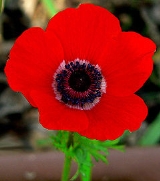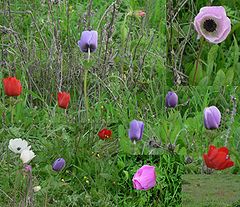
Anemone coronaria
Encyclopedia

Flowering plant
The flowering plants , also known as Angiospermae or Magnoliophyta, are the most diverse group of land plants. Angiosperms are seed-producing plants like the gymnosperms and can be distinguished from the gymnosperms by a series of synapomorphies...
in the genus Anemone
Anemone
Anemone , is a genus of about 120 species of flowering plants in the buttercup family Ranunculaceae in the north and south temperate zones...
, native to the Mediterranean region.
Description
Anemone coronaria is a herbaceousHerbaceous
A herbaceous plant is a plant that has leaves and stems that die down at the end of the growing season to the soil level. They have no persistent woody stem above ground...
perennial plant
Perennial plant
A perennial plant or simply perennial is a plant that lives for more than two years. The term is often used to differentiate a plant from shorter lived annuals and biennials. The term is sometimes misused by commercial gardeners or horticulturalists to describe only herbaceous perennials...
growing to 20–40 cm tall (rarely to 60 cm), with a basal rosette of a few leaves
Leaf
A leaf is an organ of a vascular plant, as defined in botanical terms, and in particular in plant morphology. Foliage is a mass noun that refers to leaves as a feature of plants....
, the leaves with three leaflets, each leaflet deeply lobed. The flower
Flower
A flower, sometimes known as a bloom or blossom, is the reproductive structure found in flowering plants . The biological function of a flower is to effect reproduction, usually by providing a mechanism for the union of sperm with eggs...
s are borne singly on a tall stem with a whorl of small leaves just below the flower; the flower is 3–8 cm diameter, with 5-8 red, white or blue petal
Petal
Petals are modified leaves that surround the reproductive parts of flowers. They often are brightly colored or unusually shaped to attract pollinators. Together, all of the petals of a flower are called a corolla. Petals are usually accompanied by another set of special leaves called sepals lying...
-like tepal
Tepal
Tepals are elements of the perianth, or outer part of a flower, which include the petals or sepals. The term tepal is more often applied specifically when all segments of the perianth are of similar shape and color, or undifferentiated, which is called perigone...
s.
Cultivation
Anemone coronaria is widely grown for its decorative flowers. Numerous cultivarCultivar
A cultivar'Cultivar has two meanings as explained under Formal definition. When used in reference to a taxon, the word does not apply to an individual plant but to all those plants sharing the unique characteristics that define the cultivar. is a plant or group of plants selected for desirable...
s have been selected and named, the most popular including the De Caen and St Brigid group of cultivars.
The De Caen group are hybrids cultivated in the districts of Caen and Bayeux in France in the 18th century.
Etymology
Anemone coronaria means crown anemone, evoking regal associations.The Arabic name is "شقائق النعمان | Shaqa'iq An-Nu'man" translated literally as the wounds, or "pieces", of Nu'man. One possible source of the name traces back to the Sumerian god of food and vegetation, Tammuz, whose Phoenician epithet was "Nea'man". Tammuz is generally considered to have been drawn into the Greek pantheon as "Adonis
Adonis
Adonis , in Greek mythology, the god of beauty and desire, is a figure with Northwest Semitic antecedents, where he is a central figure in various mystery religions. The Greek , Adōnis is a variation of the Semitic word Adonai, "lord", which is also one of the names used to refer to God in the Old...
". Adonis
Adonis
Adonis , in Greek mythology, the god of beauty and desire, is a figure with Northwest Semitic antecedents, where he is a central figure in various mystery religions. The Greek , Adōnis is a variation of the Semitic word Adonai, "lord", which is also one of the names used to refer to God in the Old...
died of his wounds while hunting wild boar. The deity is transformed into a flower, stained by the blood of Adonis. Tammuz's Phoenician epithet "Nea'man" is believed to be both the source of "An-Nu'man" in Arabic which came through Syriac, and of "Anemone" which came through Greek.Another possible source of the name is An-Nu'man III Bin Al-Munthir, the last Lakhmid king of Al-Hirah
Al-Hirah
Al Hīra was an ancient city located south of al-Kufah in south-central Iraq.- Middle Ages:Al Hīra was a significant city in pre-Islamic Arab history. Originally a military encampment, in the 5th and 6th centuries CE it became the capital of the Lakhmids.The Arabs were migrating into the Near East...
(582-c.609 AD) and a Christian Arab. An-Nu'man is known to have protected the flowers during his reign. According to myth, the flower thrived on An-Nu'man's grave, paralleling the death and rebirth of Adonis
Adonis
Adonis , in Greek mythology, the god of beauty and desire, is a figure with Northwest Semitic antecedents, where he is a central figure in various mystery religions. The Greek , Adōnis is a variation of the Semitic word Adonai, "lord", which is also one of the names used to refer to God in the Old...
.
In Hebrew, the anemone is "כלנית מצויה" (Calanit metzouya). "Calanit" comes from the Hebrew word "Cala כלה" which means "bride
Bride
A bride is a woman about to be married or newlywed.The word may come from the Proto-Germanic verb root *brū-, meaning 'to cook, brew, or make a broth' which was the role of the daughter-in-law in primitive families...
", "metzouya" means "common." The calanit earned its name because of its beauty and majesty, evoking a bride on her wedding day.
The Anemone coronaria grows wild all over Israel and Jordan. During the British Mandate for Palestine, British soldiers were nicknamed "Kalaniyot" for their red berets.
External links
- Comprehensive profile for Anemone coronaria, MaltaWildPlants.com
- Anemonia coronaria in israelwildflowers.co.il
- Photos of Anemone coronaria by Zachi Evenor, in FlickrFlickrFlickr is an image hosting and video hosting website, web services suite, and online community that was created by Ludicorp in 2004 and acquired by Yahoo! in 2005. In addition to being a popular website for users to share and embed personal photographs, the service is widely used by bloggers to...
- Anemone coronaria in Palestine

